Measuring Sputnik’s audience in the South Caucasus countries
Content from local, independent outlets has
Measuring Sputnik’s audience in the South Caucasus countries

Content from local, independent outlets has a broader social distribution network than Sputnik affiliates in Armenia, Georgia, and Azerbaijan
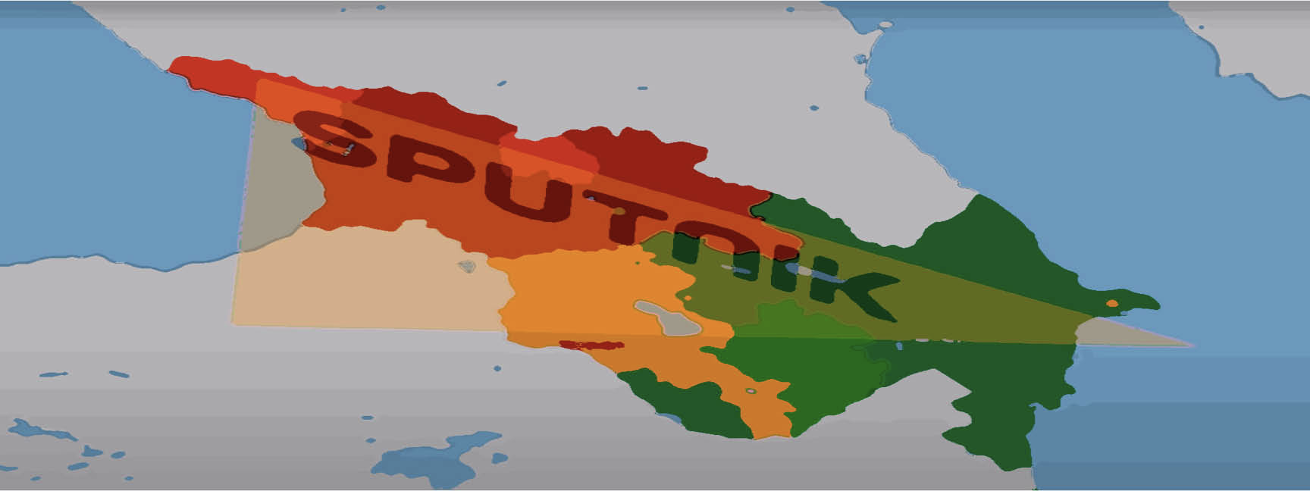
This story was published in partnership with On.ge. სტატია ვრცლად წაიკითხეთ აქ.
Content from local, impartial media outlets in three South Caucasus countries appears to be distributed by a broader network on social media than that of Sputnik’s content focused on the region. Although cumulative traffic to the websites of three local independent outlets was greater than traffic to Sputnik’s websites in the South Caucasus region, there is a big discrepancy between countries. That said, people in the region engage with content generated by local outlets on social media more often than they do Sputnik’s content. This finding indicates that content from the local outlets is more popular among local audiences than Sputnik’s content.
Sputnik’s various regional bureaus regularly engage in spreading disinformation, and Sputnik Armenia, Georgia, and Azerbaijan are no exception. For example, both Sputnik Armenia and Sputnik Georgia spread coronavirus disinformation suggesting that the novel virus is a biological weapon. Sputnik Azerbaijan, meanwhile, has falsely claimed that the United States had plans to invade Kaliningrad, an isolated part of Russia sandwiched between Poland, Lithuania, and the Baltic Sea. In one of the more nefarious applications of the media outlet, the Kremlin uses Sputnik to interfere in other countries’ elections. The Mueller report on Russian interference in the 2016 U.S. presidential election confirmed that Sputnik and RT, another Kremlin-funded outlet, tried to influence voter attitudes in the United States ahead of the 2016 elections and disseminated hacked material prior to the election itself. Apart from spreading false information, Sputnik has also used coordinated inauthentic networks on social media to grow its audience and establish itself as a trusted source in the region, in violation of Facebook’s community standards. Against this background, Sputnik’s work in the South Caucasus countries adds to worries about the Kremlin’s ability to use it as a means of interfering in domestic affairs and manipulating public opinion.
Traffic volume to Sputnik versus local outlets
The DFRLab examined the performance of Sputnik Armenia, Sputnik Azerbaijan, and Sputnik Georgia through three different metrics: (1) analyzing traffic volume on their websites; (2) measuring the social distribution network of each outlet based on volume of their news content shared on Facebook and Twitter; and (3) analyzing the volume and nature of engagements generated by their Facebook pages. The DFRLab compared Sputnik’s performance in the region with the performance of three well-established local outlets: CivilNet in Armenia, Oxy.az in Azerbaijan, and Netgazeti in Georgia.
According to domain analytics tool SimilarWeb, the Sputnik Armenia website registered unusually high traffic from May to July 2020, over three times the traffic of Sputnik Azerbaijan and Sputnik Georgia combined. The traffic on Sputnik Armenia was over 30 times higher than that of CivilNet, considered a well-estabilished and reliable source of news in the country.
Sputnik Georgia registered slightly less traffic than Netgazeti, one of the most popular Georgian news outlets with balanced reporting. Lastly, Oxu.az registered significantly higher traffic than Sputnik Azerbaijan.
The overall sum of traffic on these Sputnik domains from May to July 2020 was almost 19 million visits, while traffic to the impartial local outlets for the same period exceeded 25.5 million visits. The DFRLab selected only local language editions from both categories in each country for its SimilarWeb analysis. However, we selected all Sputnik’s domains for our analysis when we measured the social distribution network using the social media monitoring tools CrowdTangle and Brandwatch.
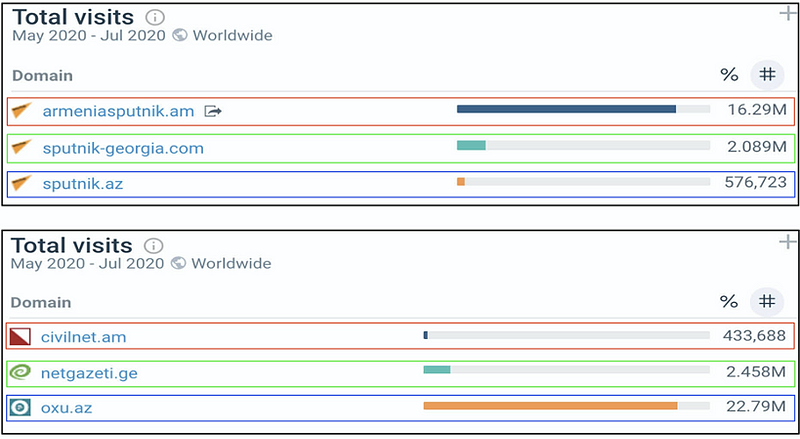
Sputnik uses various marketing channels (email, referrals, social media, etc.) to drive traffic to its websites in the South Caucasus. Incoming traffic from social networks to Sputnik Armenia and Sputnik Azerbaijan was much lower (3.72 and 9.40 percent, respectively) during the period of May-July 2020 than to the Sputnik Georgia website (41.67 percent). When it comes to local outlets, 61.5 and 53.7 percent of CivilNet and Netgazeti traffic, respectively, is driven through social networks, while the share of social media referrals in the traffic to Oxu is around 6 percent. Both Sputnik and the local news outlets use Facebook as the primary social network from which to drive traffic to their websites.

SimilarWeb analysis also showed that almost 60 percent of total visits to the three Sputnik websites in South Caucasus came from Russia. Of these, Sputnik Armenia registered over 99 percent of visits as coming from Russia and only slightly more than 4 percent of visits to all Sputnik outlets in the region came from Azerbaijan. As for local news outlets, the traffic share from Russia is much smaller in comparison with that of Sputnik’s traffic. Oxu garnered the highest number of visitors among local outlets, and, apart from this, SimilarWeb shows that over 20 percent of visitors to Azerbaijani outlet Oxu was from Armenia, a disproportionate volume of visitors to another country’s outlet in comparison to Azerbaijani and Georgian visitors who — by a nearly complete margin — stuck to their own country’s outlet.

Social distribution network on Facebook
To measure the social distribution network, the DFRLab collected posts on Facebook and Twitter that included news content linked to Sputnik’s outlets in the South Caucasus countries. According to the Oxford Internet Institute, the social distribution network of an outlet is the sum of follower counts of the Facebook groups, Facebook pages, and Twitter accounts that shared at least one piece of content from the outlet during the observation window.
The DFRLab examined Sputnik’s content shared on Facebook and Twitter between August 1, 2019, and August 1, 2020, and compared the results with three well-established and impartial local outlets in the region, as shown in the table below. This allowed for a better sense of an approximate number of people exposed to Sputnik’s content vis-à-vis content generated by reliable outlets in the region. The results indicate that, although Sputnik’s distribution network reached more than 25 million followers on both Facebook and Twitter, the local outlets have a broader distribution network of 40 million followers on both social media platforms combined.
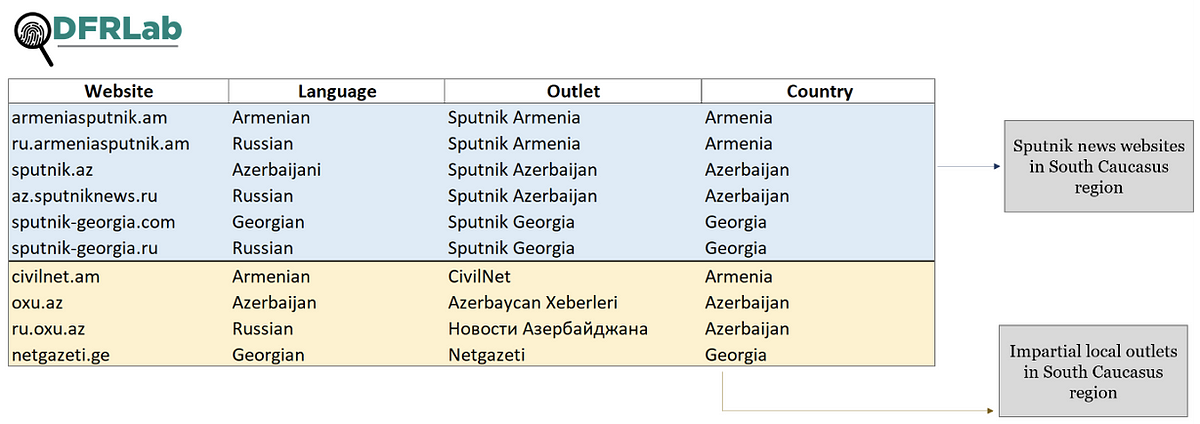
Using the social media-monitoring tool CrowdTangle, the DFRLab tracked nearly 85,000 links shared on Facebook, of which 45 percent corresponded to Sputnik’s news content in the South Caucasus countries, while 55 percent corresponded to the impartial local outlets.
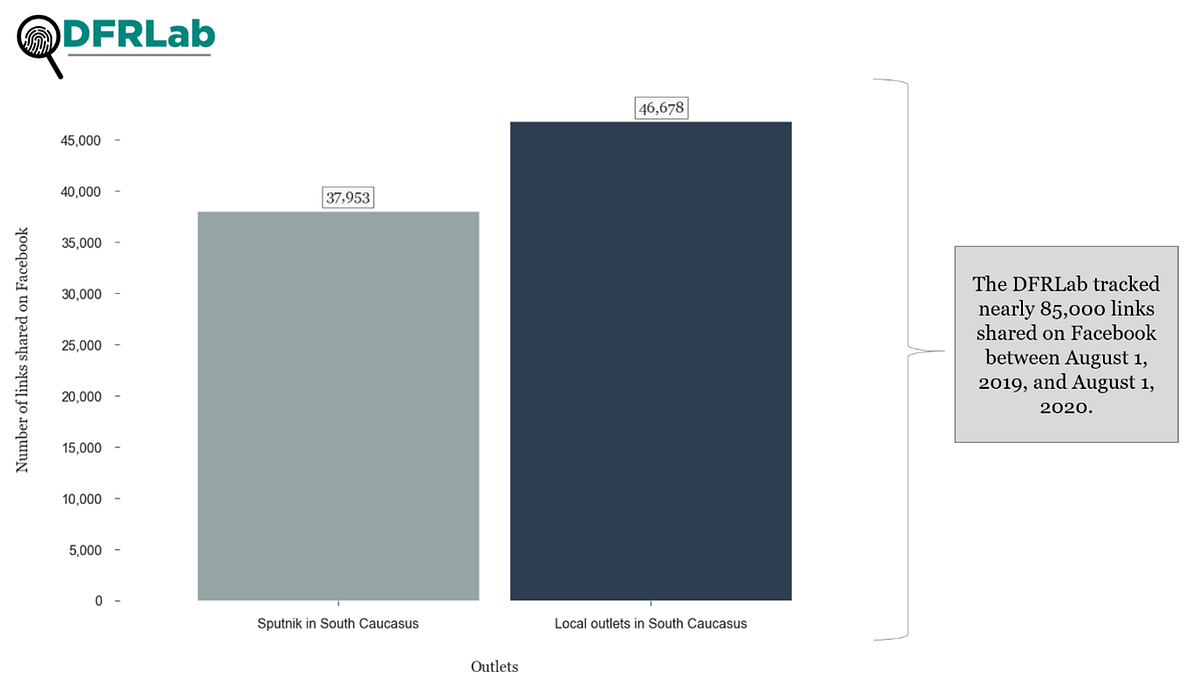
Over the one-year period of analysis, 495 Facebook assets, including Facebook pages, groups, and profiles, shared at least one piece of content from these Sputnik outlets. In total, these Facebook assets amassed a social distribution network of nearly 18 million followers, based on the sum of follower counts of Facebook groups, pages, and public profiles.
The local outlets in the region, on the other hand, gathered a social distribution network of nearly 35 million followers combined, based on 822 Facebook assets that shared their content at least once from August 1, 2019, to August 1, 2020. This demonstrated that the social distribution network of these local outlets was almost twice the size of the Sputnik outlets on Facebook.
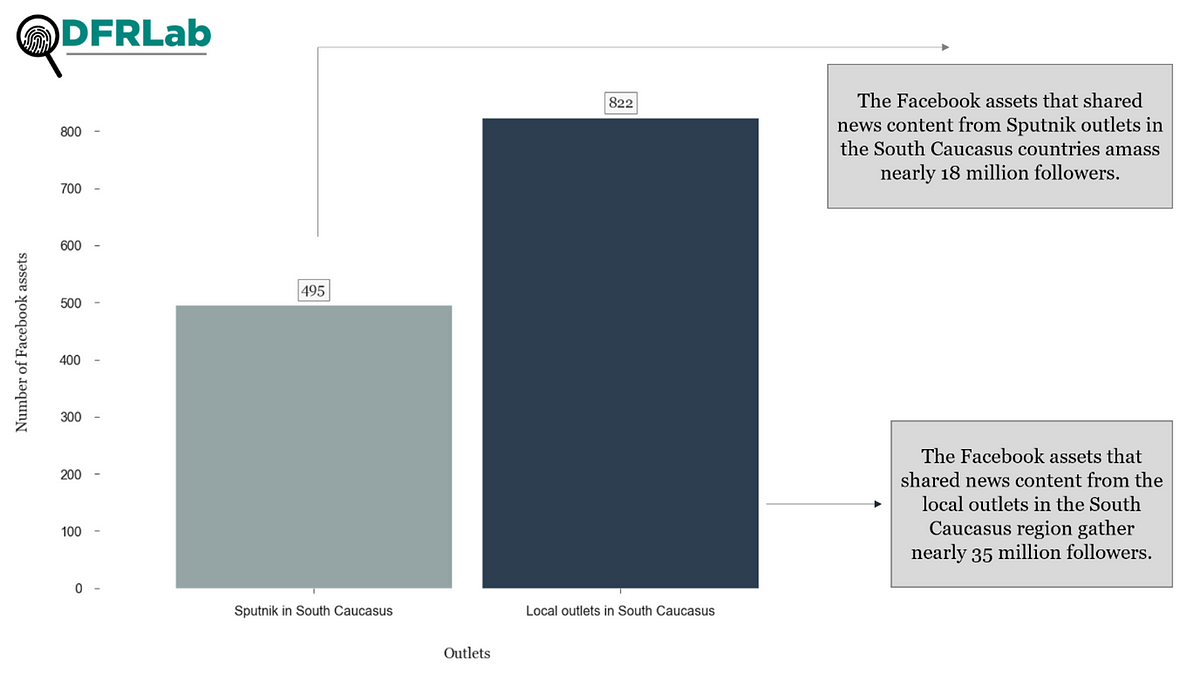
Social distribution network on Twitter
An analysis performed by the DFRLab using the tool Brandwatch showed that, between August 1, 2019, and August 1, 2020, around 3,000 Twitter accounts shared at least 10,000 links belonging to Sputnik’s websites in the South Caucasus countries, while more than 2,500 accounts shared almost 70,000 links from impartial local outlets in the region.
Although Twitter accounts shared more news content from local outlets, Sputnik’s content has a greater social distribution network in the South Caucasus countries: 8 million Twitter accounts compared to slightly more than 5 million for the local outlets.

Engagement with content shared in social distribution networks
The DFRLab analyzed the levels of engagement with content belonging to Sputnik’s news websites in the South Caucasus countries. The research measured the engagement by aggregating the sum of actions that users of both Facebook and Twitter took in response to the content shared by the distribution network. On Facebook, users’ actions include shares, comments, likes, and reactions, while on Twitter, actions refer to replies, retweets, and favorite counts.
Impartial local outlets generated more engagement than Sputnik in the region: around 5.5 million engagements to 1 million engagements, respectively, during the period of analysis.
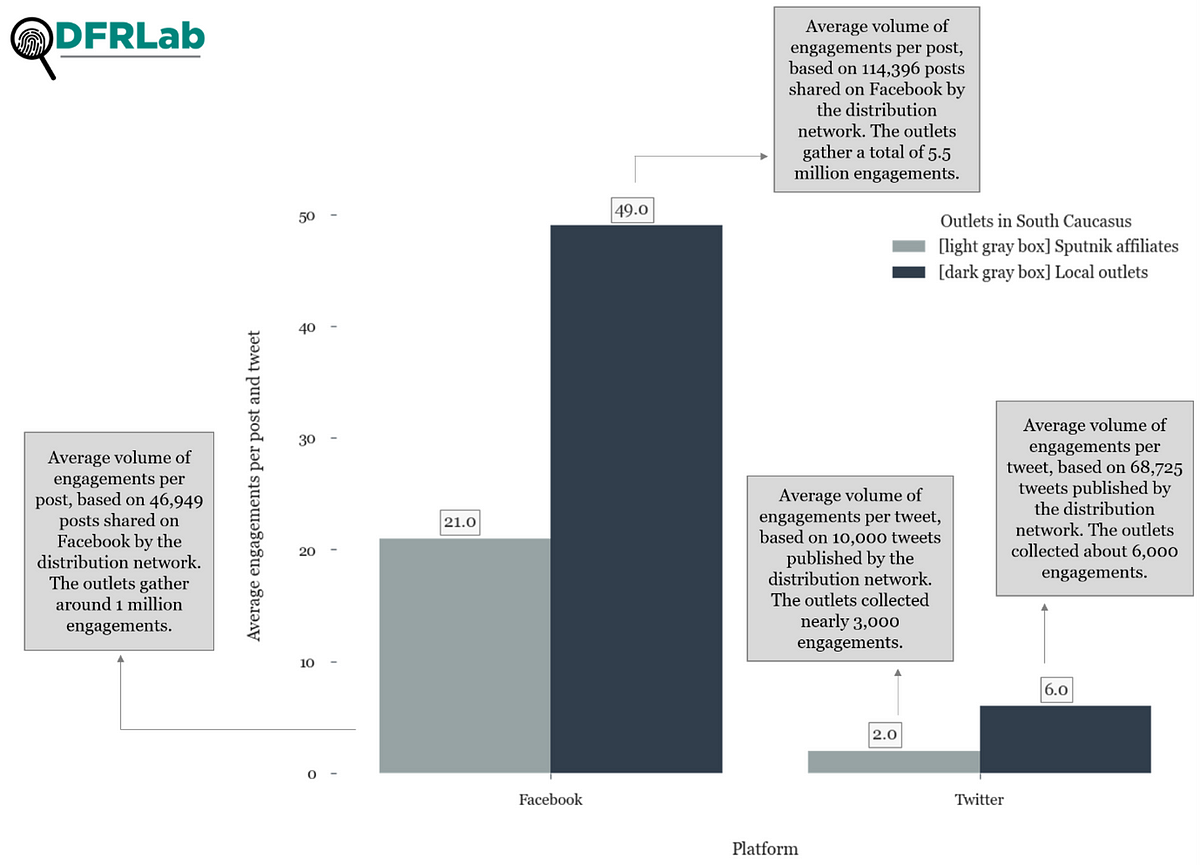
The following image shows disaggregated data of actions that Facebook users took in response to the shared content.

The DFRLab examined the volume of engagements by outlet. The Georgian local outlet Netgazeti.ge gathered more than 2 million engagements between August 1, 2019, and August 1, 2020. Among the Sputnik outlets from the South Caucasus countries, Sputnik Georgia collected the highest volume of engagements. The local outlet with the smallest engagement volume, civilnet.am, nevertheless still received more engagement than the most engaged-with Sputnik affiliate, that of Sputnik Georgia.

As a Russian state-controlled media agency, Kremlin-funded Sputnik has prompted concerns that the Kremlin would use it as a tool for influencing public opinion in the countries in which it operates. Over the last five years, Sputnik has managed to build a sizeable social distribution network in the South Caucasus. However, its reach and influence appear limited in comparison to well-established, independent local outlets. There are significant discrepancies between countries in terms of traffic to Sputnik’s regional websites: Sputnik Armenia garnered remarkably higher traffic than an independent counterpart, Civilnet, whereas traffic to Azerbaijan’s independent outlet Oxu.az was much higher than that of Sputnik Azerbaijan. In spite of these discrepancies, trusted local news outlets have wider social distribution networks and garner more engagement on social media. While the reason for the apparent preference for local, independent outlets in two of the three South Caucasus countries is not entirely clear, the Kremlin’s continuous meddling in regional affairs likely has made local audiences skeptical of Russian state media.
Givi Gigitashvili is a Research Assistant, Caucasus, with the Digital Forensic Research Lab.
Esteban Ponce de León is a Research Assistant, Latin America, with the Digital Forensic Research Lab.
This research is part of the #ElectionWatch Georgia project in partnership with On.ge, made possible through support from East-West Management Institute (EWMI) and US Agency for International Development (USAID). Contents of this report are the sole responsibility of the author and do not necessarily reflect the views of EWMI, USAID or US Government.
Follow along for more in-depth analysis from our #DigitalSherlocks.

